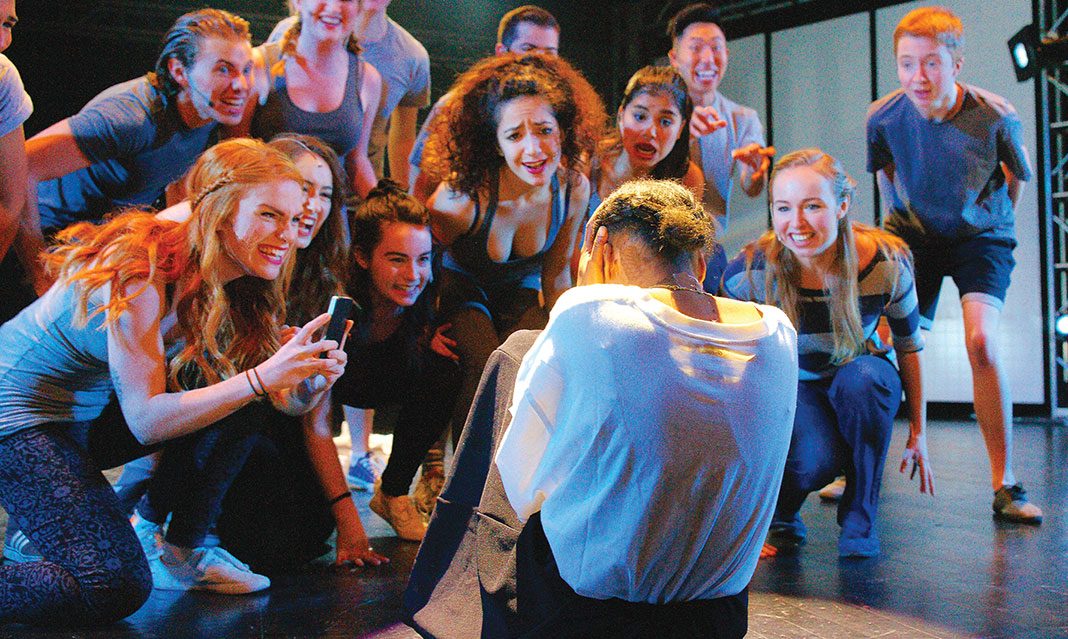What happens when you combine music with horror?
I asked myself this question when I first heard the title of Hart House’s latest production, Carrie: The Musical. Prior to the show, I wouldn’t think that Stephen King’s iconic novel, Carrie, invited any kind of musicality. How does one unite gore and dancing? Nonetheless, I entered the play’s premiere last Friday with an open mind. Evil Dead did it, so why should Carrie be an exception?
Under Richard Ouzounian’s direction, Carrie: The Musical features original music and choreography. The songs consisted of several high-tempo tunes. But overall, the music was slow and soulful. The lyrics were often clichéd, as they covered trite subjects such as love and finding oneself. Let me remind you that Carrie falls into the horror genre.
Carrie takes us back to high school, where popular cliques rule the school and outcasts live on the fringe. Mean-girl Chris Hargensen (Madison Sekulin) and her boyfriend Billy Nolan (Stephane Gaudet) torment Carrie White (Tiyana Scott). They lead their group of friends into a constant ring of bullying, mocking Carrie at every opportunity. At home, Carrie meets further abuse. Her mother, Margaret (Brittany Miranda), shelters Carrie and imposes religion upon her.
Carrie’s life appears bleak until her classmate, Sue Snell (Jacqueline Godbout), discovers a twinge of sympathy and attempts to earn Carrie’s forgiveness. But Chris and Billy have other plans. As the high school drama unfolds, Carrie discovers a hidden ability for telekinesis. Her powers emerge when she gets angry, resulting in doors slamming and light bulbs burning out. Carrie’s powers build as her tormentors persist.
The setting is sparse, but effective. Three large walls frame the stage. The walls contain moving panels that rotate for scene changes. In the shower scene, for example, the panels turn to reveal white-tiled walls. The walls also punctuate Carrie’s powers. When Carrie slams doors using her telekinesis, she flings her arms towards the open panels and they slam shut. Other than the multifunctioning walls, the stage contains platforms that elevate characters during songs and dramatic moments. They also act as seats for the characters during gatherings.
Carrie’s character is victimized in this production, more so than the original story. King depicts Carrie as a victim, but with an eerie and unsettling undertone. We feel sorry for Carrie, but not really. In contrast, Ouzounian portrays Carrie as a sad, abused girl. That ominous layer doesn’t exist in this production. Carrie: The Musical generally downplays the horror aspect of the story, largely owing to the style of music. Carrie’s powers barely make an appearance, except in the conclusion. Many important scenes of her violence are cut from this script, which can lead to a confusing ending if you’re unfamiliar with the story.
These changes can be attributed to Ouzounian’s intentions with the script. In the Director’s Note, he explains that he wanted to explore the issue of bullying and emphasize its importance throughout the production. While I respect Ouzounian’s message, I don’t believe Carrie is the right outlet. Yes, King sought inspiration from his own experiences with bullying, and there’s nothing wrong with drawing from that inspiration in an original production. However, it shouldn’t dominate the script. Ouzounian overtook the production with a completely new meaning. He detracted from the horror aspect in favour of teaching a lesson about bullying. As a result, he distorted the original story.
Music and direction aside, there were many strong features of this production. Scott carried the lead role. She sang with confidence and grace, transcending the quality of the music. Miranda also radiated power with her vocals. Her duets with Scott were the highlight of the production. Miranda slipped into the character of Margaret with agility. She seamlessly transitioned between her character’s two personalities: loving mother and unhinged, biblical woman.
Perhaps my favourite moment in the show was Margaret’s song, “I Remember How Those Boys Could Dance.” The choreography in this piece contained passionate movements that complemented the song’s message. Margaret delves into this song after Carrie reveals her plans to attend prom. Margaret tries to warn Carrie about boys, recalling a scene where Carrie’s father tempted and sexually assaulted her. As Margaret sings, a couple enters the stage. The woman wears black lingerie and the man wears black briefs. They engage in an intimate dance. Miranda stands with a haunted expression as the couple moves around her.
In one moment, Miranda backs onto a platform and the woman stands in front of her, with her back to Miranda. As Miranda moves her arms to emphasize her lyrics, the woman performs the same action. The man appears behind Miranda and begins grazing her body with his hands. The three move in sync as Miranda continues to sing. Eventually, the couple leaves Miranda and digresses into their dance once again. The couple grows violent as Miranda’s lyrics increase in explicitness. Although the song reveals a dark and erotic moment, the choreography reflects the subject matter in a tasteful way. The movements are elegant and well-rehearsed. This piece contributes a new context to Margaret’s character. The audience witnesses her vulnerability, stemming from her sexual assault.
The cast of Carrie: The Musical comprised a talented group of individuals. However, their abilities were dwarfed by the mediocre music and unfavourable script. I’ll return to my earlier question: What happens when you combine music with horror? Regrettably, not much.
Carrie: The Musical runs until February 4 at Hart House Theatre.



